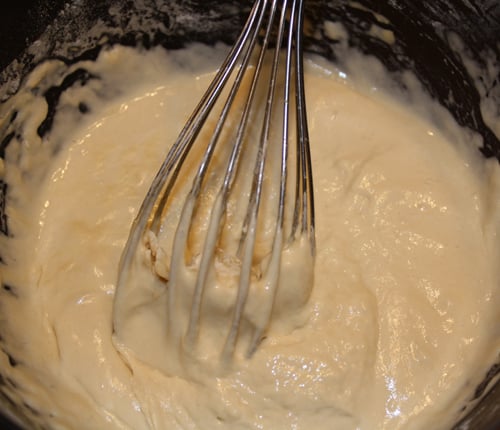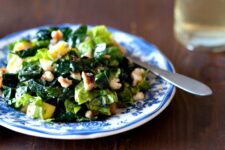This Rosemary Bread with Walnuts and Olives recipe blends the aromatic depth of rosemary with the hearty textures of walnuts and olives. It’s ideal for anyone wanting to incorporate a touch of garden freshness into their baking.

Making homemade bread is something I have done sporadically over the years. I’ve made all different types and I’ve found that sourdough consistently yields the best results, even though it does require patiences. This makes me happy because I really enjoy the process of making sourdoughs. I also love the flavor complexity of sourdough, and I feel these breads are generally healthier and more digestible.
Rosemary is a perennial herb that is generally easy to grow in a sunny spot in the garden. It has many uses in cooking, and is also said to have medicial and even cosmetic uses. Rosemary is high in volatile oils and has a wonderful aroma and flavor when it is used in recipes.
This bread starts with a “poolish”. A poolish is a type of starter that contains just a bit of yeast. In this case, it is a very tiny amount. Start your poolish in the evening so it can ferment while you’re sleeping, then plan to make the bread the next day. Make sure to read the recipe through so you have an idea of when you’ll need to be available to work on the bread. There’s not a ton of hands-on time needed, but it’s probably best make this on a day when you’re home for most of the day (a weekend day, perhaps).

To make the poolish, you’ll whisk the yeast and the cup of water together and allow to stand for five minutes. Then you’ll add some of the yeast water to the flour, along with the lukewarem water so that you end up with a very runny, gloppy batter.

Cover the poolish with plastic wrap or a damp cloth and let it ferment for 12 hours (overnight), or until its bubbling and starting to foam.

You’ll want to use a stand mixer with a dough hook to combine the ingredients for the bread with the poolish, then let it rest. After the dough has rested, add the olives and continue to mix until it is very smooth (about 5 minutes).

Take the dough out of the mixing bowl onto a floured surface, flatten it out with your hands, and sprinkle it with the walnuts. Knead the bread by hand until all of the walnuts are incorporated.

Wash and dry your mixing bowl. Rub it with olive oil, place your bread dough in, and cover with plastic wrap or a damp cloth. Let it ferment until light and doubled in bulk, about 6 hours.
After the dough has risen, punch it down and divide into two equal portions. Knead each ball a bit more, and then “round the loaves,” which means you’ll cup your hands around the dough and rotate it in circles until a smooth ball forms. Place your dough balls onto an oiled cookie sheet (or one that is lined with parchment paper and has been sprinkled with cornmeal).
Allow to rise for about 1 hour; preheat the oven about 30 minutes into this rising.
Slash the loaves 3-4 times with a serrated knife before you put them in the oven, and allow to bake for 30-40 minutes, or until well-browned and hollow sounding when you knock on the bottom. Allow to cool for 20-30 minutes on a wire rack before slicing.

Alternatively, if you have a baking stone and don’t mind baking your loaves separately, place the stone in the oven before you heat it and clear all racks above the one you are using. When the oven is hot, sprinkle the baking stone with cornmeal, slash the top of your loaf, and place on top of your baking stone. Bake for 30-40 minutes. Repeat with the other loaf.

Rosemary Bread with Walnuts and Olives
Ingredients
For the Poolish
- 1/4 tsp instant yeast
- 1 cup water
- 2 cups all-purpose flour
- water lukewarm
For the Bread
- 3 cups all-purpose flour
- 1 tbsp salt
- 1 tbsp rosemary fresh leaves, chopped
- 1/4 tsp instant yeast
- 3/4 cup water lukewarm
- 2 tbsp olive oil
- fermented poolish
- 1 cup olives pitted and chopped
- 1 cup walnuts toasted, cooled, and chopped
Instructions
For the Poolish
- Whisk the yeast and the 1 cup water together. Allow to stand for 5 minutes.
- Add 1/4 cup of the yeast water to the flour. Add the lukewarm water and mix. You will end up with a very gloppy batter.
- Cover with plastic wrap or a damp cloth and let it ferment for 12 hours overnight, or until its bubbles are popping and the top is starting to foam.
For the Bread
- Using a stand mixer, combine the flour, salt, rosemary and yeast in the mixing bowl. Add the water and oil to the poolish, stir to loosen it, and pour it into the flour mixture. Using the dough hook, mix on low speed until a rough dough forms. Cover and let it rest for 10 minutes.
- After the dough has rested, add the olives and continue to mix until it is very smooth (about 5 minutes).
- Take the dough out of the mixing bowl onto a floured surface, flatten it out with your hands, and sprinkle it with the walnuts. Knead the bread by hand until all of the walnuts are incorporated.
- Wash and dry your mixing bowl. Rub it with olive oil, place your bread dough in, and cover with plastic wrap or a damp cloth. Let it ferment until light and doubled in bulk, about 6 hours.
- After the dough has risen, punch it down and divide into two equal portions. Knead each ball a bit more, and then cup your hands around the dough and rotate it in circles until a smooth ball forms. Place your dough balls onto an oiled cookie sheet. Allow to rise for about 1 hour; preheat the oven to 400°F about 30 minutes into this rising.
- Slash the loaves 3-4 times with a serrated knife before you put them in the oven, and allow to bake for 30-40 minutes, or until well-browned and hollow sounding when you knock on the bottom. Allow to cool for 20-30 minutes on a wire rack before slicing.







